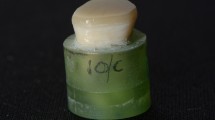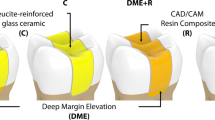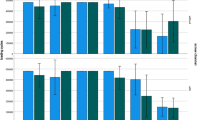Abstract
Objective
To evaluate the effects of cusp inclination of the prosthetic preparation’s occlusal surface and type of restorative material on the fatigue behavior, failure mode, and stress distribution of occlusal veneers.
Materials and methods
Glass fiber–reinforced epoxy resin prosthetic preparations for occlusal veneers with three different occlusal surface cusp inclination degrees (0°, 15°, and 30°) were produced and assigned into six testing groups (n = 11) according to the cusp inclination (0°, 15°, or 30°) and type of restorative material (lithium disilicate—LD or resin composite—RC). Despite different substrate preparation cusp inclination degrees, the restorations were designed maintaining 30° inclination between the cusps at the occlusal surface and a thickness of 0.7 mm at the central groove region of the restorations to be machined in a CAD/CAM system. After cementation, the specimens were stored for about 7 days (under water at 37 °C), and subsequently submitted to a load to failure test (n = 2) and an intermittent cyclic fatigue test (n = 9) (initial load: 100 N; step size: 50 N; cycles/step: 10,000; loading frequency: 20 Hz; loading piston: 6-mm-diameter stainless steel) until observing cracks. The data were analyzed by two-way ANOVA, Kaplan–Meier, and Mantel-Cox post hoc tests. Finite element analysis (FEA) and fractographic analyses were performed.
Results
The fatigue performance of LD and RC occlusal veneers was evaluated based on different prosthetic preparation cusp inclinations. The 0° inclination showed the best fatigue performance for both materials (LD: 944N, RC: 861N), while the 15° and 30° inclinations had lower values (LD: 800N and 533N, RC: 739N and 717N, respectively). The study also found that for a 0° inclination, LD occlusal veneers performed better than RC ones (LD: 944 N > RC: 861N), while for a 30° inclination, RC occlusal veneers had better fatigue performance than LD ones (LD: 533N < RC: 717N). No significant difference was observed between the materials for a 15° inclination (LD: 800N = RC: 739N). The FEA results showed a higher tensile stress concentration on lithium disilicate than on resin composite occlusal veneers. All lithium disilicate occlusal veneers showed radial crack failures, while resin composite occlusal veneers showed Hertzian cone cracks and radial cracks combined.
Conclusion
Considering mechanical perspective only, RC occlusal veneers should be indicated when prosthetic preparation cusps inclinations are 30°. When 0° prosthetic preparation cusps inclinations are observed, LD occlusal veneers will behave mechanically better. When a 15° cusp inclination is preserved, both restorative materials behave similarly.





Similar content being viewed by others
References
Donovan T, Nguyen-Ngoc C, Abd Alraheam I, Irusa K (2021) Contemporary diagnosis and management of dental erosion. J Esthet Restor Dent 33:78–87. https://doi.org/10.1111/jerd.12706
Bartlett D, Ganss C, Lussi A (2008) Basic Erosive Wear Examination (BEWE): a new scoring system for scientific and clinical needs. Clin Oral Investig 12:65–68. https://doi.org/10.1007/s00784-007-0181-5
Grippo JO, Simring M, Schreiner S (2004) Attrition, abrasion, corrosion and abfraction revisited. J Am Dent Assoc 135:1109–1118. https://doi.org/10.14219/jada.archive.2004.0369
Dietschi D, Argente A (2011) A comprehensive and conservative approach for the restoration of abrasion and erosion. Part I: concepts and clinical rationale for early intervention using adhesive techniques. Eur J Esthet Dent 6:20–33
Donovan T, Swift EJ (2009) Dental erosion. J Esthet Restor Dent 21:359–364. https://doi.org/10.1111/j.1708-8240.2009.00291.x
Schlichting LH, Maia HP, Baratieri LN, Magne P (2011) Novel-design ultra-thin CAD/CAM composite resin and ceramic occlusal veneers for the treatment of severe dental erosion. J Prosthet Dent 105:217–226. https://doi.org/10.1016/S0022-3913(11)60035-8
Magne P, Schlichting LH, Maia HP, Baratieri LN (2010) In vitro fatigue resistance of CAD/CAM composite resin and ceramic posterior occlusal veneers. J Prosthet Dent 104:149–157. https://doi.org/10.1016/S0022-3913(10)60111-4
Van Dijken JWV, Hasselrot L (2010) A prospective 15-year evaluation of extensive dentin–enamel-bonded pressed ceramic coverages. Dent Mater 26:929–939. https://doi.org/10.1016/j.dental.2010.05.008
Johnson AC, Versluis A, Tantbirojn D, Ahuja S (2014) Fracture strength of CAD/CAM composite and composite-ceramic occlusal veneers. J Prosthodont Res 58:107–114. https://doi.org/10.1016/j.jpor.2014.01.001
Demarco F (2011) Erosion and abrasion on dental structures undergoing at-home bleaching. Clin Cosmet Investig Dent 18:45–52. https://doi.org/10.2147/CCIDEN.S15943
Albelasy EH, Hamama HH, Tsoi JKH, Mahmoud SH (2020) Fracture resistance of CAD/CAM occlusal veneers: a systematic review of laboratory studies. J Mech Behav Biomed Mater 110:103948. https://doi.org/10.1016/j.jmbbm.2020.103948
Schlichting LH, Resende TH, Reis KR et al (2022) Ultrathin CAD-CAM glass-ceramic and composite resin occlusal veneers for the treatment of severe dental erosion: an up to 3-year randomized clinical trial. J Prosthet Dent 128:158.e1-158.e12. https://doi.org/10.1016/j.prosdent.2022.02.009
Belli R, Geinzer E, Muschweck A et al (2014) Mechanical fatigue degradation of ceramics versus resin composites for dental restorations. Dent Mater 30:424–432. https://doi.org/10.1016/j.dental.2014.01.003
Venturini AB, Prochnow C, Pereira GKR et al (2019) Fatigue performance of adhesively cemented glass-, hybrid- and resin-ceramic materials for CAD/CAM monolithic restorations. Dent Mater 35:534–542. https://doi.org/10.1016/j.dental.2019.01.013
Morimoto S, Rebello de Sampaio FBW, Braga MM et al (2016) Survival rate of resin and ceramic inlays, onlays, and overlays. J Dent Res 95:985–994. https://doi.org/10.1177/0022034516652848
Kunzelmann KH, Jelen B, Mehl A, Hickel R (2001) Wear evaluation of MZ100 compared to ceramic CAD/CAM materials. Int J Comput Dent 4:171–184
Magne P, Perakis N, Belser UC, Krejci I (2002) Stress distribution of inlay-anchored adhesive fixed partial dentures: a finite element analysis of the influence of restorative materials and abutment preparation design. J Prosthet Dent 87:516–528. https://doi.org/10.1067/mpr.2002.124367
Egilmez F, Ergun G, Cekic-Nagas I et al (2018) Does artificial aging affect mechanical properties of CAD/CAM composite materials. J Prosthodont Res 62:65–74. https://doi.org/10.1016/j.jpor.2017.06.001
Tekçe N, Pala K, Demirci M, Tuncer S (2016) Changes in surface characteristics of two different resin composites after 1 year water storage: An SEM and AFM study. Scanning 38:694–700. https://doi.org/10.1002/sca.21317
Alghauli M, Alqutaibi AY, Wille S, Kern M (2023) Clinical outcomes and influence of material parameters on the behavior and survival rate of thin and ultrathin occlusal veneers: a systematic review. J Prosthodont Res 67:45–54. https://doi.org/10.2186/jpr.JPR_D_21_00270
Dederichs M, Viebranz S, An H, et al (2022) Wear pattern‐associated color stability of prefabricated composite veneers versus ceramic veneers. J Prosthodont 1–7. https://doi.org/10.1111/jopr.13617
Zamboni SC, Nogueira L, Bottino MA et al (2014) The effect of mechanical loading on the cusp defection of premolars restored with direct and indirect techniques. J Contemp Dent Pract 15:75–81. https://doi.org/10.5005/jp-journals-10024-1191
Marini G, Saldanha da Rosa L, Machado PS et al (2023) Fatigue performance analysis of strength-graded zirconia polycrystals for monolithic three-unit implant-supported prostheses. J Mech Behav Biomed Mater 140:105736. https://doi.org/10.1016/j.jmbbm.2023.105736
Velho HC, da Rosa LS, Dapieve KS et al (2023) How does the occlusal contact region influence the mechanical fatigue performance and fracture region of monolithic lithium disilicate ceramic crowns? J Mech Behav Biomed Mater 140:105746. https://doi.org/10.1016/j.jmbbm.2023.105746
Demachkia AM, Velho HC, Valandro LF et al (2023) Endocrown restorations in premolars: influence of remaining axial walls of tooth structure and restorative materials on fatigue resistance. Clin Oral Investig. https://doi.org/10.1007/s00784-023-04895-6
Ottoni R, Marocho SMS, Griggs JA, Borba M (2022) CAD/CAM versus 3D-printing/pressed lithium disilicate monolithic crowns: adaptation and fatigue behavior. J Dent 123:104181. https://doi.org/10.1016/j.jdent.2022.104181
Chen Y, Maghami E, Bai X et al (2023) Which dentine analogue material can replace human dentine for crown fatigue test? Dent Mater 39:86–100. https://doi.org/10.1016/j.dental.2022.11.020
Bergamo ETP, Bordin D, Ramalho IS et al (2019) Zirconia-reinforced lithium silicate crowns: effect of thickness on survival and failure mode. Dent Mater 35:1007–1016. https://doi.org/10.1016/j.dental.2019.04.007
Sasany R, Yilmaz B (2022) Marginal discrepancy and fracture load of thermomechanically fatigued crowns fabricated with different CAD-CAM techniques. J Prosthodont. https://doi.org/10.1111/jopr.13612
Sirous S, Navadeh A, Ebrahimgol S, Atri F (2022) Effect of preparation design on marginal adaptation and fracture strength of ceramic occlusal veneers: a systematic review. Clin Exp Dent Res 8:1391–1403. https://doi.org/10.1002/cre2.653
Mueller B, Pilecco RO, Valandro LF et al (2023) Effect of immediate dentin sealing on load-bearing capacity under accelerated fatigue of thin occlusal veneers made of CAD-CAM glass-ceramic and resin composite material. Dent Mater 39:372–382. https://doi.org/10.1016/j.dental.2023.03.003
Gierthmuehlen PC, Jerg A, Fischer JB et al (2022) Posterior minimally invasive full-veneers: effect of ceramic thicknesses, bonding substrate, and preparation designs on failure-load and -mode after fatigue. J Esthet Restor Dent 34:145–153. https://doi.org/10.1111/jerd.12861
Abu-Izze FO, Ramos GF, Borges ALS et al (2018) Fatigue behavior of ultrafine tabletop ceramic restorations. Dent Mater 34:1401–1409. https://doi.org/10.1016/j.dental.2018.06.017
Ivoclar (2018) Tetric CAD: Pretreatment and cementation of Tetric CAD restorations with Multilink Automix. https://www.ivoclar.com/en_li/downloadcenter/#dc=global&lang=en&search-text=tetriccad&details=20110. Accessed 15 May 2023
Kelly JR, Rungruanganunt P, Hunter B, Vailati F (2010) Development of a clinically validated bulk failure test for ceramic crowns. J Prosthet Dent 104:228–238. https://doi.org/10.1016/S0022-3913(10)60129-1
Velho HC, Dapieve KS, Borges ALS et al (2022) Effects of material and piston diameter on the fatigue behavior, failure mode, and stress distribution of feldspathic ceramic simplified restorations. J Mech Behav Biomed Mater 134:105398. https://doi.org/10.1016/j.jmbbm.2022.105398
Velho HC, Dapieve KS, Rocha Pereira GK et al (2020) Accelerated loading frequency does not influence the fatigue behavior of polymer infiltrated ceramic network or lithium disilicate glass-ceramic restorations. J Mech Behav Biomed Mater 110:103905. https://doi.org/10.1016/j.jmbbm.2020.103905
Dibner AC, Kelly JR (2016) Fatigue strength of bilayered ceramics under cyclic loading as a function of core veneer thickness ratios. J Prosthet Dent 115:335–340. https://doi.org/10.1016/j.prosdent.2015.09.017
de Carvalho Ramos N, Campos TMB, de La Paz IS et al (2016) Microstructure characterization and SCG of newly engineered dental ceramics. Dent Mater 32:870–878. https://doi.org/10.1016/j.dental.2016.03.018
Machry RV, Borges ALS, Pereira GKR et al (2021) Influence of the foundation substrate on the fatigue behavior of bonded glass, zirconia polycrystals, and polymer infiltrated ceramic simplified CAD-CAM restorations. J Mech Behav Biomed Mater 117:104391. https://doi.org/10.1016/j.jmbbm.2021.104391
Faul F, Erdfelder E, Lang A-G, Buchner A (2007) G*Power 3: a flexible statistical power analysis program for the social, behavioral, and biomedical sciences. Behav Res Methods 39:175–191. https://doi.org/10.3758/BF03193146
Weitzel ISSL, Rangel JHR, Perim MP et al (2020) Mechanical performance of monolithic materials cemented to a dentin-like substrate. J Prosthet Dent 123:753.e1-753.e7. https://doi.org/10.1016/j.prosdent.2019.12.021
Dapieve KS, Machry RV, Pereira GKR et al (2021) Alumina particle air-abrasion and aging effects: fatigue behavior of CAD/CAM resin composite crowns and flexural strength evaluations. J Mech Behav Biomed Mater 121:104592. https://doi.org/10.1016/j.jmbbm.2021.104592
Machry RV, Dapieve KS, Valcanaia A et al (2022) Thickness and internal adjustment of monolithic resin composite milled crowns: effect on the load-bearing capacity under fatigue. J Mech Behav Biomed Mater 134:105407. https://doi.org/10.1016/j.jmbbm.2022.105407
Zhang Y, Bhowmick S, Lawn BR (2005) Competing fracture modes in brittle materials subject to concentrated cyclic loading in liquid environments: monoliths. J Mater Res 20:2021–2029
Funding
This study was partly supported by the Brazilian Federal Agency for Coordination of Improvement of Higher Education Personnel – CAPES, Brazil (Grant # 001, Doctorate Scholarship of H.C.V. and K.S.D), by the Foundation to Research Support of the Rio Grande do Sul State (FAPERGS; Grants #18/2551-0000520-7 and #19/2551-0001221-7), and by Brazilian National Council for Scientific and Technological Development (CNPq) (Grants #308427/2021-1).
Author information
Authors and Affiliations
Contributions
Helder Callegaro Velho: conceptualization, data curation, formal analysis, methodology, writing—original draft. Kiara Serafini Dapieve: methodology, formal analysis, data curation, writing—review and editing. Elisa Donária Aboucauch Grassi: methodology, formal analysis, data curation, writing—review and editing. Alexandre Luis Souto Borges: data curation, methodology, writing—review and editing. Renata Marques de Melo Marinho: data curation, methodology, writing—review and editing. Gabriel Kalil Rocha Pereira: supervision, formal analysis, data curation, writing—review and editing, validation. Andressa Borin Venturini: conceptualization, supervision, formal analysis, data curation, writing—review and editing. Luiz Felipe Valandro: conceptualization, supervision, funding acquisition, formal analysis, data curation, writing—review and editing.
Corresponding author
Ethics declarations
Informed consent
Written informed consent was taken from all participants included in the study.
Conflict of interest
The authors declare no competing interests.
Additional information
Publisher's note
Springer Nature remains neutral with regard to jurisdictional claims in published maps and institutional affiliations.
Rights and permissions
Springer Nature or its licensor (e.g. a society or other partner) holds exclusive rights to this article under a publishing agreement with the author(s) or other rightsholder(s); author self-archiving of the accepted manuscript version of this article is solely governed by the terms of such publishing agreement and applicable law.
About this article
Cite this article
Velho, H.C., Dapieve, K.S., Grassi, E.D.A. et al. Fatigue behavior, failure mode, and stress distribution of occlusal veneers: influence of the prosthetic preparation cusp inclinations and the type of restorative material. Clin Oral Invest 27, 5539–5548 (2023). https://doi.org/10.1007/s00784-023-05173-1
Received:
Accepted:
Published:
Issue Date:
DOI: https://doi.org/10.1007/s00784-023-05173-1




